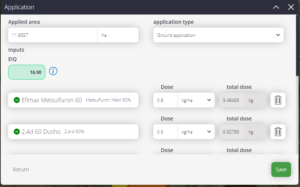The Environmental Impact Quotient (EIQ) is an indicator that allows evaluating the environmental impact generated by the application of phytosanitary products (insecticides, fungicides, and herbicides).
Within the platform, when creating an application, you will find a new field called “Field EIQ“. This index will provide values that reflect the environmental impact per hectare of the phytosanitary mixture based on the selected active ingredients and doses in this activity.
These values will allow you to compare the environmental impact between different management strategies and recipes.
Various factors are considered to calculate the EIQ:
- Toxicity (dermal, avian, chronic, bee, fish, beneficial arthropod)
- Half-life in the Soil
- Leaching Potential
- Half-life on the Plant Surface
- Effects on Applicator, Consumer, and Environment.
- Among others.
The result is a unique number that describes the EIQ of the active ingredient of a phytosanitary product and is calculated using the following formula:
Field EIQ = EIQ x % Concentration of the active ingredient x Dose

Reference table for Field EIQ values:
< 5 are very low (shown in green)
≥5 ≤ 25 are low (shown in green)
25 ≤ 45 are medium (shown in yellow)
45 are high (shown in red)



This index is very useful for identifying which agronomic recipe generates less environmental impact and thus carrying out more sustainable production.
☝🏼 IMPORTANT: If you want to access more information, click here
